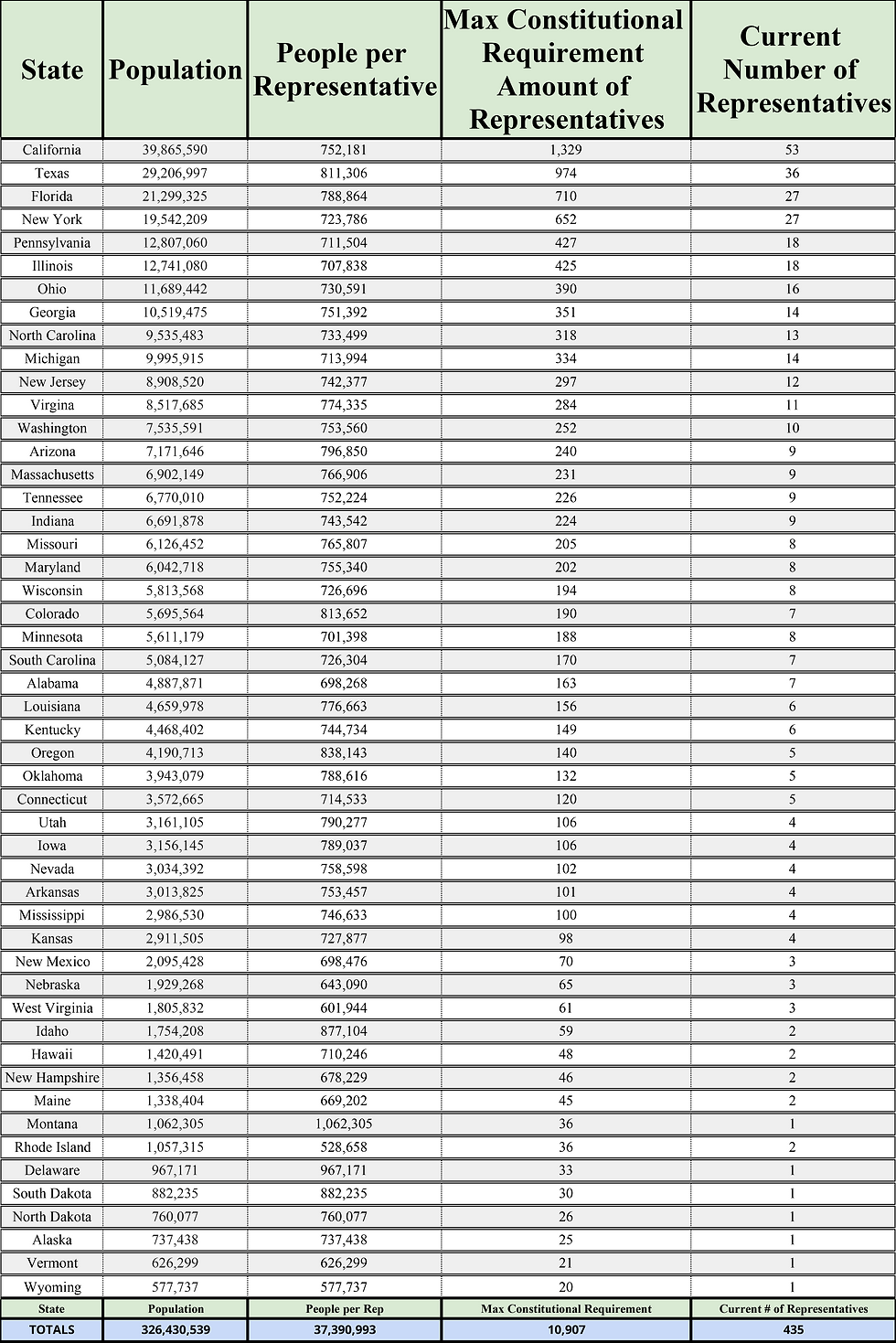A Hypothetical House of Representatives (Why the Census Matters)
- Jan 8, 2020
- 4 min read
Alright y'all, let's get right to it! I know I have some friends from other countries, so first, a brief explanation of the legislative branch. The United States has a bicameral legislature, that means there's two chambers of Congress. There's the Senate, where each state gets two people to represent them. Then there's the House, which is based upon population size...or at least, it was. Each state is guaranteed at least one Representative, and then the remaining 51-435th seats are apportioned based on some fancy looking math.
Equal Proportions Method P - represents a state's total population n - represents the number of seats a state would have if it gained a seat (because all states automatically received one seat the next seat gained is "seat two," and the next "seat three," and the next "seat four," and so on.) The multiplier equals: 1 divided by the square root of n(n-1) [which is called the reciprocal of the geometric mean].
Here's the thing though...435 people representing over 320 million is far from representative. In the Constitution, it is stated there should no more than one Representative per every 30 thousand people. It's also stated that a census will be carried out every 10 years in order to properly apportion the House seats. Apparently, this process always caused contention between urban and rural areas (some things never change), eventually leading to the Permanent Apportionment Act of 1929, forever freezing the number of Representatives at 435.
So what did I do? I did the math! If the House was actually apportioned at the maximum limit, there would be over 10,000 members of the House. This would, of course, be extremely unweildly; I mean, it already takes long enough for anything to get done. The least populous state, Wyoming, they get 20 Representatives! The most populous, California, gets 1,329! My state, New Jersey, gets 297!

Why the Census Matters
So, given that the overall number cannot change, if one state loses a member, another state must gain. This would work perfectly well if we only had inter-state migration, but there's also immigrants, and people tend to congregate in certain areas. From reports I've seen, New York is one of the most moved from states in the last decade, and California is expected to lose a seat for the first time in history (you mean, people can't afford to live in Cali?!). Southern and Western states are expected to gain a seat or two, at the expense of the northeast and rust belt states.
Now, why is the Census important if the overall number of seats doesn't change? Well, states can still lose or gain members, making them marginally more or less influential nationally. But it also counts how many people we have. Having an accurate count is important for appropriating any federal funds, such as for housing, education, healthcare, and infrastructure development (not an exhaustive list). Under-counting certain ethnic groups can be a way of intentionally diminishing their representation. That's also why it would've been great to count the number of LGBT people this time, but alas, the Trump administration didn't want that. Then Republicans would have to acknowledge that queer people exist, and even live in their states, and then they might have to provide services for them! Not surprisingly, the states that aren't investing state funds, or investing a minimal amount, in the census, are overwhelmingly Republican controlled. Communities that are less trusting of the government, such as immigrants, particularly those undocumented, are less likely to respond to the Census. If they don't respond, Republicans can then pretend they don't exist for the next 10 years.
Redistricting
This is also when states get to redraw legislative districts, which is done by whichever party is in power. Whichever party is power tends to have the habit of gerrymandering, which basically means drawing really bizarrely shaped districts to favor your party...like how Republicans will split blue (democratic) cities into several districts to avoid electing a Democrat to the House. Personally, I think a third-party organization needs to be established to create districts fairly, because otherwise states are left at the mercy of whoever happens to control state legislatures and the governorship at the start of the decade (it's primarily Republicans, this go-around).
So anyway, the US legislature is basically fucked, and I haven't even mentioned how lots of people want to fix the Senate (I mean, does it realistically make sense that Wyoming and California each get two senators? It's basically the opposite problem of the House...essentially, the Constitution was written at a time when when we were a small, mostly rural country, and does not work for modern times)
Sources
I'll find specific links to what I've read if you want, but it was all either from the New York Times or The Guardian, and general information just from googling. You can find the math on Census.gov, I don't quite understand it myself, although the formula does look familiar from a long-forgotten math class. Also, I don't know how to insert links from mobile, so there's that!




